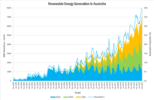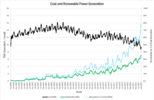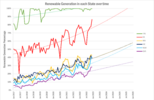paulp
Active Member
Yes they too would enjoy their power at over 40c per kwh…but easy to beat with some renewables on the roof.Imagine if all the States were as far along the curve........
You can install our site as a web app on your iOS device by utilizing the Add to Home Screen feature in Safari. Please see this thread for more details on this.
Note: This feature may not be available in some browsers.
Yes they too would enjoy their power at over 40c per kwh…but easy to beat with some renewables on the roof.Imagine if all the States were as far along the curve........
It isn't wholesale energy prices that make South Australia's retail electricity expensive: Quarterly base futures prices.Yes they too would enjoy their power at over 40c per kwh…but easy to beat with some renewables on the roof.
Yes its the poles and wires, specifically the local distribution network by sapn. this distribution cost is expensive because less people are buying power due to household and business solar, so those that are left (with no solar) have to divide up the distribution cost between them. I agree that generation is a small part of any bill in SA. Distant high voltage transmission to the outer regions is by a different company and represents less than 10% of the kwh cost. This is a similar challenge now facing motoring, and those without a renewables car having to each share a larger part of the road maintenance. Like ev’s, expect a sun tax soon.It isn't wholesale energy prices that make South Australia's retail electricity expensive: Quarterly base futures prices.
It's the network and distribution costs that are expensive, because those in Adelaide are cross-subsidising the substantial cost of running poles & wires out to all the remaining sparsely populated bits of the state. Even if the power was generated for free it would still be expensive.
this distribution cost is expensive because less people are buying power due to household and business solar, so those that are left (with no solar) have to divide up the distribution cost between them... The only way to defeat it is take control yourself with solar and battery, which actually makes it financially worse for everyone else That hasn’t done the same.
Yes agree “people are buying less power”. Daily charges are also increasing significantly, average is now probably around 90c per day. They have tried to slow the solar uptake by decreasing the FIT and threatening disconnects during peak sunlight, but thats just stimulating more batteries.Wouldn’t it be more accurate to say “people are buying less power” not “less people are buying power” because the number of people gone truly off-grid would be tiny. There’s still roughly the same number of people paying the grid daily connection charge, but certainly in SA (second highest rooftop solar penetration in the country - 42.4%) a large number of those people are either buying no net power at all (or are net exporters, and their retailer owes them money) or have massively reduced their grid consumption.
So turnover would be collapsing, and that is a problem. I would expect daily connection fees start to increase quite a lot. Merely increasing per kWh charges will just stimulate more and more solar and battery substitution. But if a solar+battery house needs grid power even < 5% of the time, they can‘t disconnect from the grid. Or it is very unlikely they will. So the daily connection fee is the price to have power available at any time, and is much harder to avoid.
What on earth? Must journalists keep demonstrating they have precisely zero knowledge of or interest in history? Must every footnote be a world-first?
Yes, the cost isn't high voltage transmission so much as the LV distribution networks out in the regional areas which are long, skinny and therefore expensive. All the states have these to some degree but SA has it the worst (and has only one DNSP covering the whole area).Distant high voltage transmission to the outer regions is by a different company and represents less than 10% of the kwh cost.
They have tried to slow the solar uptake by decreasing the FIT and threatening disconnects during peak sunlight, but thats just stimulating more batteries.
What on earth? Must journalists keep demonstrating they have precisely zero knowledge of or interest in history? Must every footnote be a world-first? For several decades pre-Basslink, Tasmania was powered entirely by renewable hydroelectric power for far longer than a week.
the SA Premier stated:Well that’s because grids running on 100% hydro or close to it are nothing new and not notable.
However statewide grids running on 100% solar and wind are completely new, and currently there is only one example in the world where that has been achieved for non-trivial amounts of time: South Australia.
So yeah, it is a world-first and worthy of coverage (notwithstanding the 2% of mandated generation from gas turbines).
"We understand that it's also a world-first for an entire jurisdiction to have all of its energy needs met across a seven-day period exclusively by renewables,"
It isnt calling out solar or wind, although the article does mention them elsewhere, but generally sticks by the theme of ‘renewables’.
Excellent, more grist for the mill in the Sydney V Melbourne rivalry.And extraordinarily NSW has beaten VIC for the first time, with VIC falling below 40% and NSW going over 40% for the first time.
Meh, whatever. What would be good would be for NSW to have heaps more solar than Queensland and change our number plates to the sunshine stateSydney V Melbourne rivalry


Great stats Vostok.As threatenedhere is my first stats dump, looking at the rise of renewables and decline of coal, updating my post from over a year ago. Data from OpenNEM.
The first chart shows growth in renewable generation since 1998.
View attachment 891351
Notable stats:
The second chart shows total renewable and coal generation, and renewables as a percentage of coal generation on the right-hand scale:
- Grid wind power first appeared in June 2007 and grid solar in March 2015.
- Renewable generation milestones (first time each TWh per month was reached):
- 2 TWh - November 2010
- 3 TWh - August 2013
- 4 TWh - July 2018
- 5 TWh - November 2020
- 6 TWh - December 2021
- 7 TWh - December 2022
- Renewable percentage milestones:
- 10% - September 2010
- 20% - October 2016
- 30% - September 2020
- 40% - November 2022
View attachment 891353
Notable stats:
Trending the trajectory forward from 2017, when coal began its terminal decline:
- As a percentage of all electricity generation, coal peaked at 96.4% in November 1999. Since then it has crossed these milestones:
- 90% - October 2004
- 80% - August 2010
- 70% - September 2013
- 60% - September 2021
- Coal's total generation peaked at 16.3 TWh in a month in July 2007
- Coal went below 10 TWh in a month for the first time in September 2021
- Coal's smallest contribution was 8.7 TWh in November 2022 - 53.5% of all generation.
- Renewables as a percentage of coal generation milestones:
- 30% - October 2016
- 40% - November 2019
- 50% - August 2021
- 60% - October 2021
- 70% - November 2022
- Coal will finally produce less than 50% of Australia's electricity some time in 2024 (trend suggests April)
- We will cross 50% renewables in 2025. But at the rate renewables are growing (and with coal-fired power stations closing this year and next) I think it will happen sooner than that - so I'm sticking my neck out and saying it will happen next year!
Thanks for putting in your time to thisAs threatenedhere is my first stats dump, looking at the rise of renewables and decline of coal, updating my post from over a year ago. Data from OpenNEM.
The first chart shows growth in renewable generation since 1998.
View attachment 891351
Notable stats:
The second chart shows total renewable and coal generation, and renewables as a percentage of coal generation on the right-hand scale:
- Grid wind power first appeared in June 2007 and grid solar in March 2015.
- Renewable generation milestones (first time each TWh per month was reached):
- 2 TWh - November 2010
- 3 TWh - August 2013
- 4 TWh - July 2018
- 5 TWh - November 2020
- 6 TWh - December 2021
- 7 TWh - December 2022
- Renewable percentage milestones:
- 10% - September 2010
- 20% - October 2016
- 30% - September 2020
- 40% - November 2022
View attachment 891353
Notable stats:
Trending the trajectory forward from 2017, when coal began its terminal decline:
- As a percentage of all electricity generation, coal peaked at 96.4% in November 1999. Since then it has crossed these milestones:
- 90% - October 2004
- 80% - August 2010
- 70% - September 2013
- 60% - September 2021
- Coal's total generation peaked at 16.3 TWh in a month in July 2007
- Coal went below 10 TWh in a month for the first time in September 2021
- Coal's smallest contribution was 8.7 TWh in November 2022 - 53.5% of all generation.
- Renewables as a percentage of coal generation milestones:
- 30% - October 2016
- 40% - November 2019
- 50% - August 2021
- 60% - October 2021
- 70% - November 2022
- Coal will finally produce less than 50% of Australia's electricity some time in 2024 (trend suggests April)
- We will cross 50% renewables in 2025. But at the rate renewables are growing (and with coal-fired power stations closing this year and next) I think it will happen sooner than that - so I'm sticking my neck out and saying it will happen next year!



